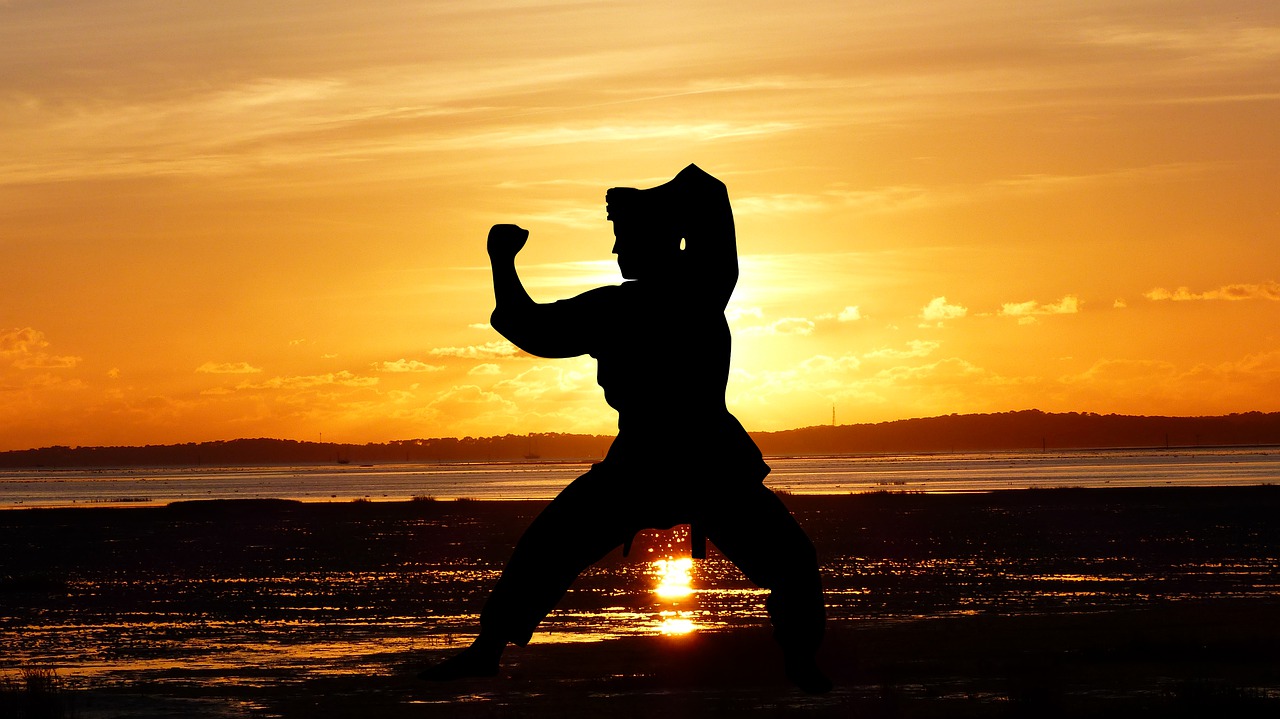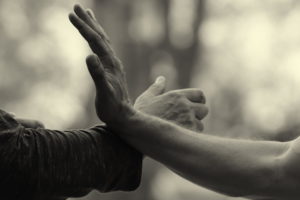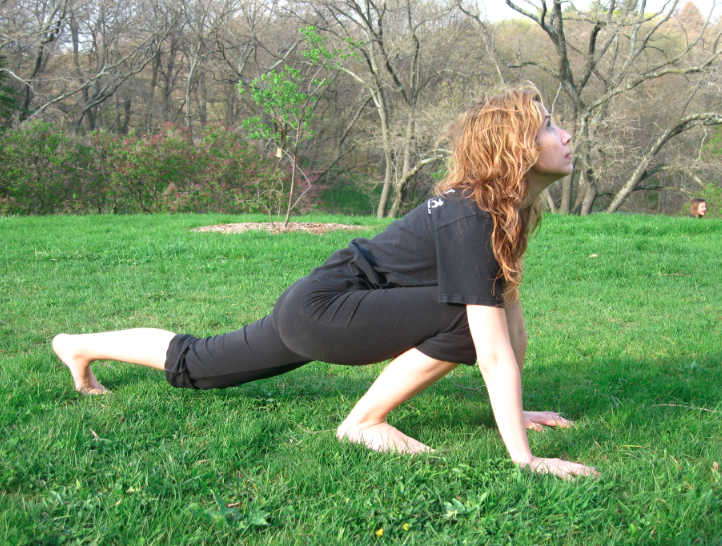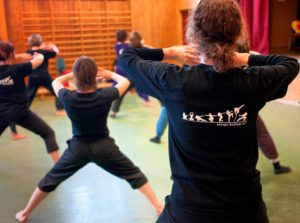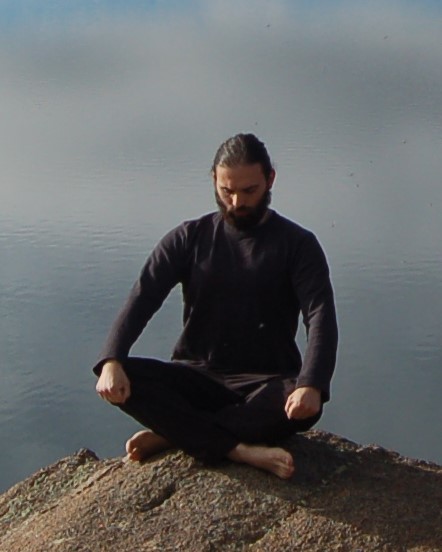When first encountering Boabom, many people ask what we mean by non contact martial arts. Most martial arts that many people have practiced or seen in movies or on TV are a physical activity that involves contact, whether striking, taking, or throwing another person. So for many of us the concept of no-contact martial arts training seems like an oxymoron. Don’t you need to make contact with another person to learn a martial art? The answer may come as a surprise, but not only do you not need to make contact with another student (or “opponent”) in order to learn a martial art, but practicing without contact can even help to improve your confidence and allow you to think more clearly if you’re ever faced with a threatening situation where you may need to defend yourself. Confused? Don’t be – here’s everything you need to know!
In This Article Non contact martial arts means just that: it’s a martial art that you can learn without having to make physical contact with another person. That means no striking and no sparring with another student. In Boabom we learn individual movements individually, which is why it’s such a great martial art to learn online, as well as in-person. When we do practice partner work, both people move in coordination with one another, but still without contact. This can look quite like sparring, but it’s also very similar to dancing, where each student moves and reacts to the other, but without any competition.
Non contact martial arts means just that: it’s a martial art that you can learn without having to make physical contact with another person. That means no striking and no sparring with another student. In Boabom we learn individual movements individually, which is why it’s such a great martial art to learn online, as well as in-person. When we do practice partner work, both people move in coordination with one another, but still without contact. This can look quite like sparring, but it’s also very similar to dancing, where each student moves and reacts to the other, but without any competition.
Q: Won’t it take me longer to learn and advance in a non-contact martial art if I’m not practicing movements on a partner? Answer
Q: Can you provide me with a list of non contact martial arts? Answer
Q: What are some tips for effectively learning a non contact martial art? Answer
Q: Do I need to have prior martial arts experience before trying a non contact martial art workout? Answer
In This Article
What Do We Mean By Non Contact Martial Arts
Why Learn a Non Contact Martial Art
No Competition, No Problem
Try a Non Contact Martial Workout Art Today
Non Contact Martial Arts Training Frequently Asked Questions
Why Learn a Non Contact Martial Art
No Competition, No Problem
Try a Non Contact Martial Workout Art Today
Non Contact Martial Arts Training Frequently Asked Questions
What Do We Mean By Non Contact Martial Arts?
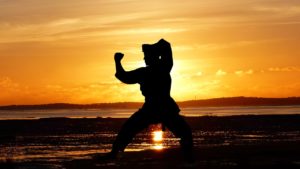 Non contact martial arts means just that: it’s a martial art that you can learn without having to make physical contact with another person. That means no striking and no sparring with another student. In Boabom we learn individual movements individually, which is why it’s such a great martial art to learn online, as well as in-person. When we do practice partner work, both people move in coordination with one another, but still without contact. This can look quite like sparring, but it’s also very similar to dancing, where each student moves and reacts to the other, but without any competition.
Non contact martial arts means just that: it’s a martial art that you can learn without having to make physical contact with another person. That means no striking and no sparring with another student. In Boabom we learn individual movements individually, which is why it’s such a great martial art to learn online, as well as in-person. When we do practice partner work, both people move in coordination with one another, but still without contact. This can look quite like sparring, but it’s also very similar to dancing, where each student moves and reacts to the other, but without any competition.Why Learn a Non Contact Martial Art?
So, why would you want to learn a non-contact martial art if you’re studying it to learn self-defense? Is it really possible to be able to defend oneself if you’ve never practiced the techniques on another individual? You absolutely can, and there are actually several benefits to opting for a contactless martial art versus one that will require you to exert force on another person. First, in Boabom we strive to create a stress-free environment for our students, as we believe there’s enough stress already in the world. We want every student to feel safe and comfortable in our classes, and one very imprtant way of doing this is to eliminate the tension that comes from potentially hurting another person and the fear of getting hurt yourself. With no worry of injuring others or themselves, Boabom students feel confident to execute the mvoements with all their energy—and this, in turn, helps them feel more confident if they’re ever faced with a threatening situation. So rather than “pulling punches,” you are able practice complete projections, only tweaking your aim. And in a tense situation where you may need to defend yourself, it’s much easier to adjust your aim than it is to unlearn the habit of only punching or kicking halfway. Studying a non-contact martial art is also great for anyone who wants to reap all of the amazing benefits of martial arts if learning self-defense isn’t a motivating factor. Because practicing something like Boabom doesn’t just teach you how to defend yourself—it can help alleviate stress and anxiety; improve your sleep, mood, and outlook; and generally aid you physically by improving your balance, strength, flexibility, coordination, cardiovascular health, and more. If you previously thought the only way you could enjoy all of these benefits was by taking up a martial art that forces you to execute the moves on an object or person, the good news is you don’t have to! The great thing about the Boabom arts is that there are several different forms. Some focus more on self defense, but all combine movement with meditation, breathing, and really help to build positive energy. There’s Seamm-Jasani, or gentle Boabom, which combines relaxation with long, slow movements and breathing forms. Then there’s Osseous Boabom, which teaches more energetic movements that develop faster reactions. We also teach Yaanbao, which is Boabom with implements such as staffs of varying lengths, which helps improve strength and develops our coordination. With so many different styles to choose from, you can study the one that aligns with your goals, both in terms of the intensity of the class and the approach to self-defense.No Competition, No Problem
Along with no contact, the Boabom arts are strictly non-competitive. This doesn’t just mean that we don’t participate in tournaments or other competitions. It also speaks to our philosophy of teaching, where each and every student is valued, and their personal progress is what is important. All of our teachers make sure that everyone is able to understand the movements, encouarging all students to measure their progress personally, without comparison or competition with their classmates. This non-competitive pedagogy helps Boabom students relax and focus, creating a special meditation and positive energy for everyone in the class. This unique approach also helps us to listen to ourselves, and gives us the confidence to understand and act on what we hear.Try a Non Contact Martial Arts Workout Today
As you can see, there’s a lot to love about non contact martial arts. If you’d like to try out a form of no contact martial arts yourself, check out our free introductory online Boabom class, as well as our regular streaming class schedule to find the one that’s right for you!Frequently Asked Questions
Q: Who should study a non contact martial art? Answer A no-contact martial art is suitable for anyone who would like to enjoy the benefits of martial arts without worrying about injuring themselves or others, or someone who has no interest in participating in a martial arts competition. Anyone of any age can study a no-contact martial art to improve their physical and emotional health without the pressure of sparring with or competing against another student.
Q: Won’t it take me longer to learn and advance in a non-contact martial art if I’m not practicing movements on a partner? Answer
Many of our Boabom students find that by eliminating the contact factor that they feel more confident and free to fully extend their arms and legs and execute the movements. We also put the focus on each individual student and their progress, so there’s no pressure to keep up with fellow students or somehow feel “better” or more advanced than other people studying the art. As a progressive martial art, we introduce the new sequences and moves gradually so that you absorb and retain them better.
Q: Can you provide me with a list of non contact martial arts? Answer
Admittedly, it’s a short list given that traditionally, the majority of martial arts focuses on sparring and competitions. But here are some to try:
- Boabom (of course!) – With roots in ancient Tibet, Boabom is comprised of different styles, or arts, so you study the one that’s right for you. There’s Seamm-Jasani, otherwise known as gentle Boabom, which uses slower movements. Osseous Boabom is faster and includes more ideas about physical defense.. And there’s also Yannbao, a kind of Boabom where we use staffs that act as an extension of the body. Each variation has its own style but all are non-contact, non-competitive martial arts.
- Tai Chi – Tai Chi is a Chinese martial art that, in most of its styles, teaches slow movements that won’t require you to make contact with another student. It is known to improve strength and coordination and to help manage stress.
- Iaido – Iaido is a Japanese martial art that focuses on sword-work and teaches you how to quickly draw your sword in response to a threat. There’s no contact or blade clashing, but it will help you develop physical strength and reaction skills. An Iaido class can be surprisingly intense and work your core muscles.
Q: What are some tips for effectively learning a non contact martial art? Answer
A. Like any other physical activity, learning a no-contact martial art requires warming up the body to help prevent injury. If you’re practicing from home, you want to make sure you create a space that’s free from obstacles so you won’t be hitting and knocking over anything and hurting yourself in the process. Create a distraction-free zone where pets and other household members can’t disturb you. Wear comfortable clothing that allows you to move freely. And perhaps most importantly, try to develop a regular practice of your chosen art and do your best when taking a class. Constancy is the key to advancing—practicing once a week for a year is better than every day for a couple of months, then stopping because you’re injured, bored, or burnt out.
Q: Do I need to have prior martial arts experience before trying a non contact martial art workout? Answer
A. Not at all. Boabom is a progressive martial art, so you’ll start your journey by learning with a class of other beginners. You don’t need prior experience in a martial art, nor do you need to be physically active regularly to begin. We always start every class with a careful sequence of warm-ups that get the blood flowing and loosen up our muscles, so when we get to the movements we’re ready for a good practice and much less likely to injure ourselves. We encourage you to try our free on-demand class today so you can get a taste for what non contact martial art workouts are all about!

